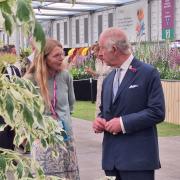Cotswold gardeners really should be growing snowdrops declares Jane Kilpatrick and, looking across her Painswick garden with winter sunshine dancing off their dainty white flowers, it’s easy to see why.
Her soil may be the usual Cotswold brash – free-draining, stony, shallow, and set on limestone – that’s characteristic for the area, but it doesn’t bother the snowdrops.
In fact, they thrive and it’s hard to move around the Cotswolds in February without seeing them. Snowdrops spread through woods, line roadside verges and there are many gardens open to show off specialist collections.
‘It's got really nothing to do with us as gardeners. It's our soil,” explains Jane. ‘Our fine, fast-draining soil is utterly perfect for them.

‘I think that certainly in this part of the world, we should all be growing snowdrops.’
It’s a connection that goes back to the start of snowdrop collecting when the area was home to some of the country’s leading galanthophiles – a term given to those who devote their time to these winter stars. Many are immortalised in the names of snowdrops: ‘Atkinsii’, Galanthus elwesii, and ‘Winifrede Mathias’.
Gloucestershire in particular has long been associated with snowdrops and was once home to Leonard and Winifrede Mathias’ Giant Snowdrop Company, the first nursery to sell snowdrops ‘in the green’ to gardeners.
Their plants were looked after by Herbert Ransom, another leading galanthophile, while at nearby Colesbourne Park, Victorian plant-hunter Henry John Elwes brought back what is now known at G. elwesii from Turkey, a snowdrop that now has many hybrids.

Jane’s walled garden is just doors away from Falkland House in Painswick where the Mathiases, Herbert Ransom and his family lived after they closed the nursery. Further up the village is the former home of James Atkins, a retired nurseryman and the first to distribute the snowdrop that became known as ‘Atkinsii. – there are large displays of it at the nearby Painswick Rococo Garden.
With all these links to the great growers of the past, writing about them seemed logical for Jane, who has authored many books. She worked with fellow historian Jennifer Harmer to produce ‘The Galanthophiles’, a history of the men and women who started the idea of collecting snowdrops.
Even so, living in the shadow of where some of them once lived does have its drawbacks: ‘Herbert Ransom had special setting pins so he knew exactly the depths to set his snowdrops because different snowdrops like different depths. So, when I’m just ramming them in because I’m running out of time or the light’s going, I’m offering apologies,’ admits Jane.

When Jane first started creating the garden for her parents 25 years ago, there were no snowdrops. In fact, the garden in the heart of Painswick had little beyond trees.
‘The first few years I spent removing a lot of what was here, conifers and all sorts of random trees,’ she recalls. ‘You couldn't even see the back wall and there were almost no herbaceous plants at all.
‘My poor father used to despair. He said, ‘I bought a garden and you're destroying it,’ and I said to him quite firmly that ‘You bought a site.’’
It took her a while to discover what would grow on the poor soil, which had not really been cultivated, before she alighted on the snowdrops.

Today, she has around 60 different varieties many of them those that featured in her book – ‘I like snowdrops that I’ve written about, that have a story.’ However, the extremely rare and usually very expensive varieties are not for her.
‘I’m not that interested in novelty for novelty’s sake,’ she says. ‘I like big snowdrops because I like to look across the garden and see a snowdrop making an impact. I don't want to have to go up to a snowdrop with a magnifying glass and saying ‘Oh, look, at mark is one millimetre longer than the mark of another snowdrop.’’
Among those snowdrops with impact that she grows are ‘John Grey’, ‘Reverend Hailstone’, ‘Bertram Anderson’, ‘Daphne’s Scissors’, named for Daphne Chapell a collector who used to garden at Dymock. There’s also ‘Maidwell L’, a cultivar of G. elwesii, ‘Lady Beatrix Stanley’ and, naturally, drifts of ‘Atkinsii’.


The white blooms are set off by the rusty tones of Libertia peregrinans, sunshine yellow winter aconites (Eranthis hyemalis) emerging foliage of ferns, or set against hellebores and the green-yellow flowers of Ribes laurifolium Rosemoor form.
When it comes to planting snowdrops, Jane believes drainage rather light levels is the key factor. Snowdrops hate having ‘wet feet’ so free-draining soil is vital whereas they will tolerate some summer sun. Under deciduous trees or shrubs is ideal as it mimics their natural habitat.
It is possible to grow them in containers but the compost must be free-draining and they are best re-potted every year. Jane does suggest growing on newly purchased snowdrops for a year in a pot before planting them out in the garden. This is because most will have been propagated from a bulb – known as twin scaling – rather than being dug from the ground.


‘They’re not that strong,’ she explains. ‘I think that as they die off, you should repot them and grow them on for another season in a pot.’
Feeding with a week phostrogen feed, such as tomato food, once the flowers have faded and before the leaves disappear will help to bulk up the bulbs and Jane also feeds those in her borders.
Snowdrop clumps should be regularly divided to stop them becoming congested. When to do it depends on who you are talking to. Some growers, such as the team at Colesbourne Park, advocate summer when the bulbs are dormant. Others do it once the flowers have faded.
Jane falls into the latter camp: ‘Frankly, who's got time the summer, who can find their snowdrops and who can see where to put them? The advice to do this in the summer is for pure, geeky snowdrop collectors.

‘For lesser mortals who grow their snowdrops as part of an overall garden, do it when you can see the snowdrops, when there's enough bare ground so that you know where you're putting them.’
To protect her bulbs from an accident slicing with a trowel later in the season, she marks each clump with a coloured plastic label.
It’s possible to have snowdrops in flower from mid-September until March with most of them flowering around February.
‘You can get very hung up on lists of lectures and everything,’ says Jane. ‘Knowing more about them is lovely, and it's really helpful but the important thing is just to go and look at them and enjoy them.’
Downton House is open for the National Garden Scheme on February 5 and 6, 2024. For details, visit www.ngs.org.uk
Instagram: @thechattygardener
Facebook: The Chatty Gardener
X: @ChattyGardener




























